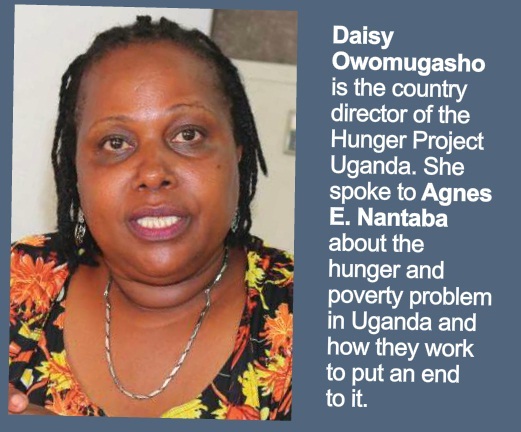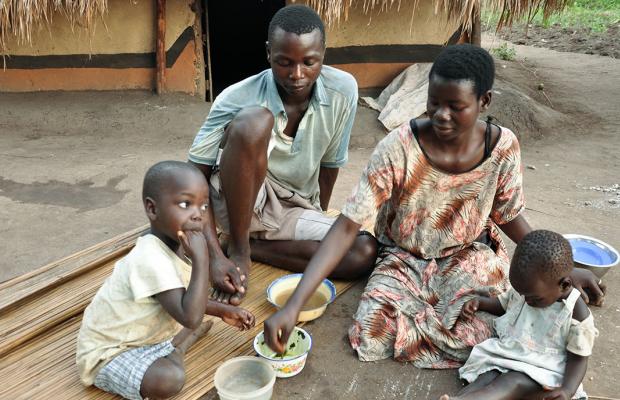
What are the key elements in your management philosophy as a manager?
My style encompasses teamwork with all stakeholders and that goes right through the external and internal publics. I therefore encourage a participatory approach to have everybody on board and talk about things. We are also a learning organization and as a manager, it calls for further research to be flexible and improve or retool in a bid to achieve the organization’s goals and objectives. We realize that a fixed mindset is one of the key blockages to development so I work to have a mindset change among employees such that they can be optimistic to work towards achieving something for the organization. It is key to making other players own up the mission and vision such that they can work within it.
What is your assessment of the hunger and poverty problem in Uganda?
We have been operational in Uganda for the last 17 years and at that time, the poverty levels or people living below the poverty line were about 43% of the population but this has dropped to 19%. It is a remarkable achievement. But that aside, we have also witnessed other changes and with the rapid population growth – that time population was about 20 million – the actual figure may remain the same. The recent research that was focusing on nutrition has revealed that from pregnancy up to two years or 1,000 days determines how people eventually turn out to be which is what we are focusing on to end hunger. There has also been a reduction in the number of poor people or those who previously had one meal per day to focusing on what makes up the one meal. Through our visits in some of the areas, we have discovered that while some families now have two or three meals a day, the important components are lacking. We can admit that it is a transition but there is need to dig deeper into the components, which translates into a nutrition aspect.
Ending hunger and poverty are some of the set of goals that countries adopted on September 25, 2015, as part of a new sustainable development goals (SDGs) agenda. How do you work strategically to achieve this agenda?
We are working towards having zero hunger and poverty by 2030. As we were reviewing SDGs last year, we realized that there is still a long way to go. For instance as Hunger Project Uganda, in geographical coverage we only cover 8% or reaching about only 1% of the population. How shall then we reach the rest of the people? We are also following the new SDGs knowing that development has to be community-led. We therefore call upon other partners to join in the genderfocused, community-led development network as we map out each individual’s contribution such that we don’t duplicate work and achieve zero hunger and poverty in Uganda by 2030.

One of the biggest blockages to ending hunger and poverty is the big divide between the rich and the poor in many parts of Uganda. How can this gap be narrowed down?
While we acknowledge that income inequality is inevitable, our strategy towards narrowing the gap is using the empowerment process. There are however encouraging signs that policies to narrow the gap are slowly beginning to work and people especially the poor are nowmore able to work their way out of poverty. Through this women have been empowered to become leaders and change agents in their communities and while we cannot put a finger on it that this is the trigger, the more they participate, the more they are empowered to work for change. With the issue of income generation, it is not only about getting knowledge but it also goes beyond to how to use it for change. This has created a change in income levels as a step ahead of moving out of poverty.
How can other stakeholders such as the government be partners to solve such challenges?
We have made an effort to partner and form alliances with other stakeholders and government which we don’t take for granted. We encourage an approach of mapping out our goals and structures as the target remains the same. This will help us cover a wider area in the shortest period of time. The government has in the recent past accepted and appreciated the epicentre methodology as a workable and cost effective approach that can lift people out of poverty and it was put in the NDP 2010-2015 although it was never implemented because of failure to place it in the right ministry. We have however not given up as the approach gives people the opportunity to get themselves involved in crafting their way out of poverty.
How do you incorporate financial management and inclusion to end poverty and hunger in Uganda?
Throughout our discoveries, we conclude that as people get empowered, they yearn to do something but some lack the financial means and for women, it can only get worse especially in the rural areas where they own nothing. We realized that some people are poor because they lack the resources and confidence to walk into any institution to seek finance. We therefore thought of an approach that can mobilize people and as they reach a certain threshold, we can provide some grant financing to help them form Saccos and start income generating activities. The approach helps in a sense that we get the really poor people who have nothing and if they agree to the concept, they can borrow from the minimum of $100. They are able to establish businesses and change their lifestyles.
 The Independent Uganda: You get the Truth we Pay the Price
The Independent Uganda: You get the Truth we Pay the Price



